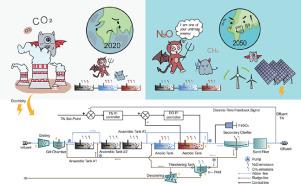Water Research ( IF 12.8 ) Pub Date : 2022-08-07 , DOI: 10.1016/j.watres.2022.118961 Aliya Abulimiti 1 , Xiuheng Wang 1 , Jinhao Kang 1 , Lanqing Li 1 , Dan Wu 2 , Zhe Li 2 , Yitong Piao 3 , Nanqi Ren 1

|
This study investigated the trade-off between energy saving and N2O emission reduction of WWTP under the precise control of dissolved oxygen (DO) concentration through model simulation. A long-term dynamic model for full-scale WWTP GHG emissions was established and calibrated with monitored year-round hourly water quality data to quantify the annual GHG emissions from WWTP. Results showed that N2O dominated the direct emission, up to 76.1%, and the variability of N2O generation could better be revealed by dynamic simulation. Furthermore, GHG emissions of the WWTP were mainly contributed by electric energy, among which the blower consumes the most electricity. To reduce the electricity consumption of blowers, improve mechanical efficiency and reduce DO concentration should be considered. DO setting played a significant role in the N2O and CH4 emission, electricity consumption and effluent quality, which was challenging to balance. The ultralow-oxygen (0–1/0.2–1 mg/L) and low oxygen (1–2 mg/L) control strategies were proposed, and their effects on total GHG emissions and effluent water quality were discussed. If the anaerobic environment (DO<0.2 mg/L)could be avoided, the control frequency (high and low) of the DO set-point did not have a significant effect on the emissions of N2O and CH4 and the effluent quality. The ultralow-oxygen strategy (0.2–1 mg/L) with a high-frequency control strategy achieved the lowest GHG emissions under the current energy mix. However, by 2050, as the energy supply gets cleaner, the total GHG emissions of WWTPs with ultralow-oxygen aeration (0.2–1 mg/L) will exceed low-oxygen aeration by 3.6%-4.2%, as N2O dominates 61.6%. Therefore, considering the trade-off between N2O emission and energy saving in WWTP, ultralow-oxygen aeration is a transition scheme to cleaner energy.
中文翻译:

基于污水处理厂全尺寸动态模拟的曝气控制N2O排放与节能的权衡
本研究通过模型模拟研究了在溶解氧(DO)浓度精确控制下污水处理厂节能与N 2 O减排之间的权衡。建立了一个全面的污水处理厂温室气体排放的长期动态模型,并使用全年监测的每小时水质数据进行校准,以量化污水处理厂的年度温室气体排放量。结果表明,N 2 O 在直接排放中占主导地位,高达 76.1%,而 N 2的变异性通过动态模拟可以更好地揭示 O 生成。此外,污水处理厂的温室气体排放主要由电能贡献,其中鼓风机耗电最多。降低鼓风机的电力消耗,提高机械效率,降低DO浓度应予以考虑。DO 设置在 N 2 O 和 CH 4中起重要作用排放量、用电量和出水水质,难以平衡。提出了超低氧(0-1/0.2-1 mg/L)和低氧(1-2 mg/L)控制策略,并讨论了它们对温室气体排放总量和出水水质的影响。如果可以避免厌氧环境(DO<0.2 mg/L),DO设定点的控制频率(高和低)对N 2 O和CH 4的排放没有显着影响和出水水质。采用高频控制策略的超低氧策略(0.2-1 mg/L)在当前能源结构下实现了最低的温室气体排放。但到 2050 年,随着能源供应更加清洁,超低氧曝气(0.2-1 mg/L)污水处理厂的温室气体排放总量将超过低氧曝气 3.6%-4.2%,其中 N 2 O 占主导地位 61.6 %。因此,考虑到污水处理厂N 2 O排放与节能之间的权衡,超低氧曝气是一种向清洁能源过渡的方案。



























 京公网安备 11010802027423号
京公网安备 11010802027423号